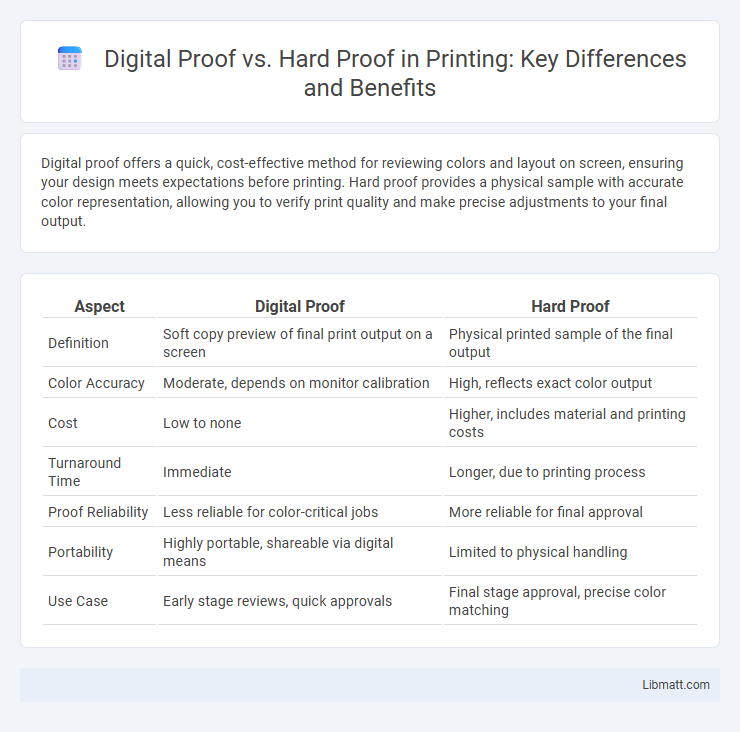Digital proof offers a quick, cost-effective method for reviewing colors and layout on screen, ensuring your design meets expectations before printing. Hard proof provides a physical sample with accurate color representation, allowing you to verify print quality and make precise adjustments to your final output.
Table of Comparison
| Aspect | Digital Proof | Hard Proof |
|---|---|---|
| Definition | Soft copy preview of final print output on a screen | Physical printed sample of the final output |
| Color Accuracy | Moderate, depends on monitor calibration | High, reflects exact color output |
| Cost | Low to none | Higher, includes material and printing costs |
| Turnaround Time | Immediate | Longer, due to printing process |
| Proof Reliability | Less reliable for color-critical jobs | More reliable for final approval |
| Portability | Highly portable, shareable via digital means | Limited to physical handling |
| Use Case | Early stage reviews, quick approvals | Final stage approval, precise color matching |
Understanding Digital Proof and Hard Proof
Digital proof offers a quick, cost-effective way to review and approve designs through on-screen previews, enabling instant adjustments and feedback. Hard proof, a physical printout of the final product, provides accurate color representation and texture, ensuring your design looks as intended in real-world conditions. Understanding these differences helps you choose the best proofing method for precise color accuracy and quality assurance in your printing projects.
Key Differences Between Digital and Hard Proof
Digital proof offers instant access and easy sharing through electronic devices, while hard proof provides tangible, color-accurate samples essential for final print verification. Digital proofs enable quick revisions and cost-effective checks without physical materials, contrasting with hard proofs which require specialized equipment and materials for accurate color reproduction. The choice between digital and hard proof hinges on project requirements for speed, accuracy, and budget constraints.
Accuracy and Color Consistency
Digital proof offers high accuracy and color consistency through advanced calibration technology and precise color management software, ensuring that on-screen colors closely match final outputs. Hard proof, created using actual printing processes and substrates, provides tangible, true-to-print color representation, critical for detecting color shifts and substrate effects. Choosing between digital and hard proofs depends on the need for immediate, iterative color adjustments versus exact physical proof validation.
Speed and Turnaround Time
Digital proofing offers significantly faster turnaround times compared to hard proofs, enabling near-instant review and approval through online platforms. Hard proofs require physical printing and shipping, which can extend the process to several days, delaying project completion. The speed advantage of digital proofs accelerates decision-making and reduces overall production timelines.
Cost Comparison: Digital vs Hard Proof
Digital proofing significantly reduces costs compared to hard proof by eliminating expenses related to physical materials, shipping, and labor-intensive processes. Hard proofs incur higher production costs due to the need for specialized printing equipment, paper, and handling, making them less economical for frequent revisions. Digital proofs offer faster turnaround and lower overhead, making them ideal for budget-conscious projects requiring multiple iterations.
Environmental Impact and Sustainability
Digital proofs significantly reduce environmental impact by eliminating the need for paper, ink, and transportation associated with hard proofs, resulting in lower carbon emissions and waste. Hard proofs, while often necessary for final color accuracy, consume more resources and generate physical waste, making them less sustainable in comparison. Choosing digital proofing supports your commitment to eco-friendly practices and sustainability goals by minimizing material use and energy consumption.
Use Cases for Digital Proof
Digital proof is ideal for quick approvals, remote collaboration, and iterative design processes where speed and convenience are crucial. Your marketing team can efficiently review and approve content without the need for physical copies, reducing turnaround times significantly. This method suits online publishing, packaging design, and any scenario requiring frequent updates or real-time feedback.
Use Cases for Hard Proof
Hard proof is essential for industries requiring color accuracy and material authenticity, such as packaging, textiles, and fine art reproduction. It allows clients and designers to evaluate the tangible qualities of a final product, including texture, finish, and color fidelity that digital proofs cannot replicate. Physical samples help prevent costly errors by providing a definitive reference before mass production.
Choosing the Right Proofing Method
Selecting the optimal proofing method requires evaluating the accuracy, cost, and turnaround time of digital proof versus hard proof. Digital proofing offers rapid, cost-effective previewing with accurate color simulations suited for quick revisions, while hard proof delivers tangible, precise color and material verification essential for final quality assurance. Understanding the specific project needs, including print fidelity and budget constraints, ensures the right proofing method enhances production efficiency and output consistency.
Future Trends in Printing Proof Technologies
Future trends in printing proof technologies emphasize the integration of augmented reality (AR) with digital proof systems, enabling more precise color accuracy and real-time adjustments. Advances in AI-driven software optimize digital proofing workflows, reducing the dependency on traditional hard proofs while improving turnaround times and sustainability. Hybrid proofing methods combining tactile hard proof elements with dynamic digital previews are gaining traction to enhance client collaboration and reduce material waste.
digital proof vs hard proof Infographic

 libmatt.com
libmatt.com